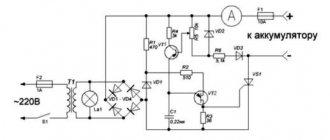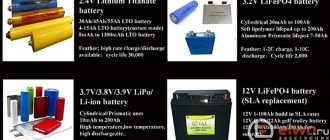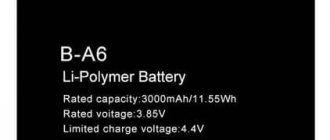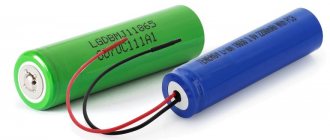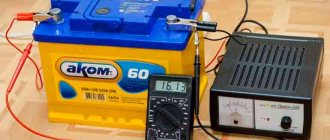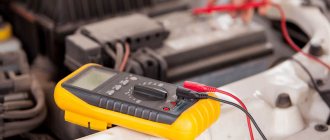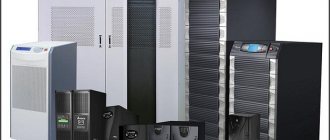A modern person cannot imagine his life without a mobile phone, tablet, laptop, portable drill, screwdriver, flashlight and other devices that can operate either from the mains or from a battery. Often, such devices use lithium-ion power sources.
Many will ask why this type of energy storage device is most often used in electrical appliances. The answer is quite simple and obvious - lithium-ion batteries are small in size, and they also have a fairly long service life - from 300 to 2000 charge-discharge cycles. Precisely because there are so many power sources of this type around us, every person should know how to charge a lithium-ion battery.
What is Li-ion battery
Despite the fact that every person has encountered such a power source, not everyone understands what kind of battery it is and how it works. The simplest and most common option is a lithium-ion power supply for mobile phones. It has the following design: on top there is a controller for charge-discharge control, and below is a battery element (bank).
99% of cell phone batteries use only one battery cell; in their jargon, experts often call it a can. The nominal voltage of this power supply is 3.7 volts.
The device also has a special controller (a regular board with a microcircuit), thanks to which the battery does not overcharge. Therefore, the manufacturer, for its part, did everything possible to ensure that no emergency situations occurred that would lead to a quick breakdown of the power source.
AAA lithium batteries
We will look at a disposable battery with a AAA lithium anode. The compact device has a passive layer on the anode that prevents a reaction. Even a short-term supply of current will destroy the layer and render the battery unusable. Unlike salt pinky batteries, lithium batteries will get so hot that they can explode. Charging lithium disposable batteries is prohibited!
If you short the plus and minus of a lithium battery, it can also catch fire. Therefore, the following rules must be observed:
- wires are not attached to the contacts with a soldering iron;
- do not carry the battery in a pocket where small metal objects may accidentally be present;
- items must be transported in a special case or case;
- Do not leave the battery in direct sunlight.
Is it worth buying a AAA lithium battery, which costs 5 times more than an alkaline battery? Considering that it works 7 times longer and is 35% lighter, it’s worth it.
How to charge for the first time
There really is such a process of first charging, it is actually necessary, but for Ni-Cd and Ni-MH batteries. Such batteries were installed in quite ancient telephones, which are now practically not produced. Not everyone knows how to properly charge a lithium-ion battery for the first time and begins to carry out the procedure of completely discharging it. Batteries of this type are designed completely differently, and the process of deep discharge is very harmful to them. That is why such devices are sold with a charge of 2/3 of the capacity, and not so that a person can check a phone or other device.
Unfortunately, quite often consumers, before charging a lithium-ion battery for the first time, remembering the old days, begin to completely discharge it, thereby almost immediately taking away half of their service life. Therefore, be careful and avoid common mistakes that lead to battery failure.
Possible risks due to incorrect charging
It is quite natural that there are certain risks that can arise from improper charging. Therefore, in order for batteries to last as long as possible, you should carefully read the instructions before using them. It is equally important to choose the right charger. Do not charge batteries at temperatures below 5 degrees and above 50 degrees Celsius. It is natural for the battery to heat up during charging. The main thing is that they are comfortable to the touch. If the heating is stronger, the device must be unplugged from the outlet.
Li-ion battery 18650
This battery has a cylindrical shape and in appearance completely resembles a regular battery. It is worth noting that unscrupulous manufacturers, trying in every possible way to increase sales, begin to indicate inflated characteristics. Today there are no more energy-intensive 18650 Li-ion batteries than 3400 mAh. If a number greater than this is indicated on the battery, then it should be understood that the manufacturer is deliberately overestimating the characteristics of its product. In this case, there is a high probability that in fact the battery will have no more than 2200 mAh.
Lithium battery sizes
To correctly select the right energy source, you need to know its geometric dimensions and shape. The indicators are standardized, let's look at the standard sizes of lithium disposable batteries. The US classification is used.
| Sign | V (V) | H (mm) | D (mm) | Popular name | Size marking |
| AAA | 1,5 | 44,5 | 10,5 | pinky | 03 |
| AA | 1,5 | 50,5 | 14,5 | finger | 6 |
| WITH | 1,5 | 50,0 | 26,2 | Thumbelina | 14 |
| D | 1,5 | 61,5 | 34,2 | barrel | 20 |
| RRZ | 9,0 | 48,5 | 26,5 | crown | 6/22 |
Individual types of lithium batteries can be seen in the photo.
crown inch finger
When choosing a lithium battery, the marking is important; it can be used to determine the type of element. For a lithium battery, CR will be printed on the case in large letters, for an alkaline battery, LR, for a salt battery, R.
Are lithium batteries always preferable to alkaline batteries? The products work great in any conditions. But is it always economically profitable to buy a lithium battery 5 times more expensive if at low current they are 1.5-2 times superior to alkaline ones? Which is better is decided in each case, in relation to the tasks being solved.
It is necessary to take into account that the energy reserve of all types of lithium batteries is several times greater. In order not to confuse the devices, manufacturers make Li batteries with special terminals.
What are the dangers of overcharging and deep discharge?
Due to the fact that people do not know how to charge a lithium-ion battery, they often make mistakes and may keep it on charge for too long or, conversely, forget about it for a long time. What are the dangers of improper battery use? The thing is that in this case, lithium ions move from one electrode to another. The material used to make the electrodes themselves may vary, but in this topic these details are not so important.
Simply put, the more charged the battery, the more lithium ions are present in the electrode. If their value is constantly at the maximum, then in this case the device wears out quite quickly.
Lithium or alkaline batteries, which is better?
Alkaline and alkaline batteries are the same thing. We will use testing by Roskontrol specialists of AAA batteries and compare them with lithium batteries. Since there are no ideal elements for cases of pulsed and constant moderate and weak loads, it is proposed to determine where it is preferable to use alkaline batteries and where lithium batteries and which ones are better.
Research results have shown that for high-power pulsed current loads it is better to buy a lithium battery - it will last as long as 3 alkaline ones, but it weighs much less than an emergency supply of several other types.
It is optimal to use alkaline batteries in remote controls and watches, and in children's toys; they are more cost-effective. Low currents quickly deplete the charge of a lithium battery, and it will last almost as long as an alkaline one.
How to charge batteries
Li-ion batteries have also become very popular because there are quite a large number of options for how to charge them.
The most logical and correct way to charge a lithium-ion battery is with a standard charger. Thanks to a special device, the battery will receive maximum charge in the shortest possible time. Moreover, it is completely safe for the battery.
For those who do not know how to charge a lithium-ion battery if they do not have a standard charger at hand, we inform you that this can also be done using a computer and a USB cable. However, in this case, the current will reach only 0.5 amperes.
It is also possible to charge the Li-ion battery through the cigarette lighter in the car. Today, many stores sell special USB adapters that deliver different currents. It is best to find out what current to charge lithium-ion batteries in the documentation that comes with your phone, laptop or other device. The bulk of batteries are charged from 3.7 to 19 volts. However, there are battery models that require more or less voltage. In any case, you shouldn’t take risks, but it’s better to look at the instruction manual once again.
If none of the previous charging methods worked, you can use an old, but still relevant device to this day, which is popularly called “frog”. Such devices are mostly designed for cell phone batteries. The design of the “frog” is quite simple: there is one dock where a lithium-ion battery is installed, as well as contacts that are adjustable in width. Thus, this charger is suitable for almost any battery of this type.
As you can see, there are a lot of ways to charge a battery. But before you charge a lithium-ion battery, you should make sure that it really is not possible to use standard charging. Other methods are used if necessary. They do not harm the battery, but still the original charge should be a priority over the others.
If a person does not know how to charge the lithium-ion battery of a screwdriver, then we inform you that this should only be done with the specialized charger that comes with the device. It is worth noting that if the charger fails and it is not possible to purchase a new one, for example, this model is no longer produced, then in this case you can connect several 18650 batteries together and insert them into the box with the original charger. It is impossible to say how many 18650 batteries are needed, it all depends on the voltage of the screwdriver.
The structure and composition of a lithium battery
Galvanic cells operating on an irreversible oxidation reaction are described here. The given charge is not restored, the battery is called disposable. The element consists of an anode made of metal lithium, a cathode made of solid MnO2, Fes2, Cuo, CFx, liquid SO2, SOCl2. The search for other salts with high affinity for reduction continues. The oxidizing agent is active lithium, which donates electrons. The battery case is sealed, with terminal leads and their markings. The inscription “do not recharge” - do not charge again, will warn that the lithium battery is disposable.
There are 2 types of batteries by design:
- reel;
- spiral.
Reel lithium batteries last up to 20 years and are used by consumers not exceeding a demand of 150 mA. The service life of the elements is up to 20 years.
Spiral designs have a large lithium surface, pulse up to 4 A, and at constant current - 0.1-1.8 A. But the self-discharge of these devices reaches 10% per year of the original capacity. Elements with any cathode composition are produced in two types. Lithium batteries can be round, prismatic or button shaped.
EVE, Minamoto, SAFT, Robiton, Varta, Tekcell are considered large and recognized manufacturers of lithium batteries. There are small production facilities in China.
Properties of lithium batteries with different anode pairs
Depending on the chemical composition of the cathode in conjunction with lithium metal, the capacitance and voltage at the terminals of the element, their self-discharge and ability to operate in a temperature range change.
- Li/MnO2 – lithium battery is marked as “CR”. The electrolyte is lithium perchlorate. Rated voltage 3 V, self-discharge 2.5% per year, shelf life up to 10 years. Working environment temperature -20 +55 0 C. Form – tablet predominates.
- Li/CuO, with an operating voltage of 1.2-1.5 V, is identical to alkaline, but it holds 3 times more charge. Operating temperature range -10 +70. Service life 10 years.
- Li/SO2 are one of the most common types of lithium batteries. The cathode is a plasticizer with graphite and carbon black. The electrolyte is liquid dioxide with components for electrical conductivity. The operating voltage is 2.6-2.9 V. The design could not avoid an increase in pressure in the housing and strong heating during a short circuit; it was necessary to install a pressure fuse. Lithium batteries work well in cold temperatures down to -60 0 and in heat of +70 0, retaining a charge for up to 10 years.
- Li/I2 is a type of battery without electrolyte. The chemical reaction 2Li+I2 >2LiI occurs in a solid composition by diffusion. The resulting salt is also hard and acts as a separator. The battery lasts up to 15 years, is reliable, and is used in pacemakers.
- Li/FeS2 - the best lithium batteries, in demand, despite the high price. Such elements work with high-power devices, have current protection, a fuse that operates at 85-90 0 and a pressure relief valve. Most often used in the AA form factor.
- Li/CFx is a type of lithium battery that operates at high temperatures, up to +85 0. Over 10 years, 20% of the capacity is consumed by self-discharge. Used in defibrillators, pacemakers and portable electronics.
- Li/SOCl2 is the most energy-intensive lithium battery. The no-load voltage is greater than 3.6 V. During operation, 3.3-3.5 V is maintained. Thionyl chloride, an aggressive component, is used as an electrolyte. The upper limit of performance is +(85-130) 0 C. The lower limit is minus 60, but with a greatly reduced element capacity. Explosion protection is provided in the form of a thermal switch, fuses and an overpressure valve.
Calibration
To do this, allow the battery to completely discharge. In this case, the battery controller will be able to independently calibrate the limits of the full charge and discharge of the device. This is necessary so that the device in which the Li-ion battery is installed displays up-to-date information about its charge. If the battery has not been completely discharged for a long time, unreliable information about the battery percentage may be displayed. After the battery is completely discharged, it must be fully charged to 100% with the device turned off. You can see the battery charging time in the instructions. If at the end of this time you turn on the device and the charge shows less than 100%, then you need to turn it off again and continue charging until the charge level is full.
Storage
If you do not plan to use the battery for a long period of time, you should pay special attention to how it should be stored. The optimal charge is considered to be 30-60% of the capacity. The battery should be located in a fairly cool room where the air temperature remains around 15 degrees. If the battery is stored in a fully charged state, then the next time you turn it on you will find that its capacity has decreased significantly.
When the device is left completely discharged, it is even worse. With a high degree of probability, in six months it will need to be recycled. Lithium-ion batteries should not be stored for long periods of time in deep discharge.
